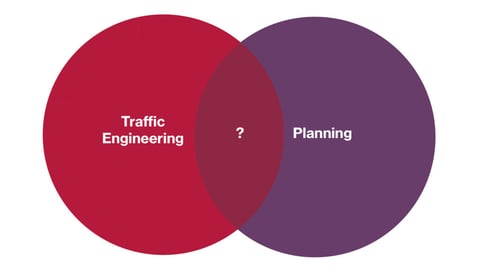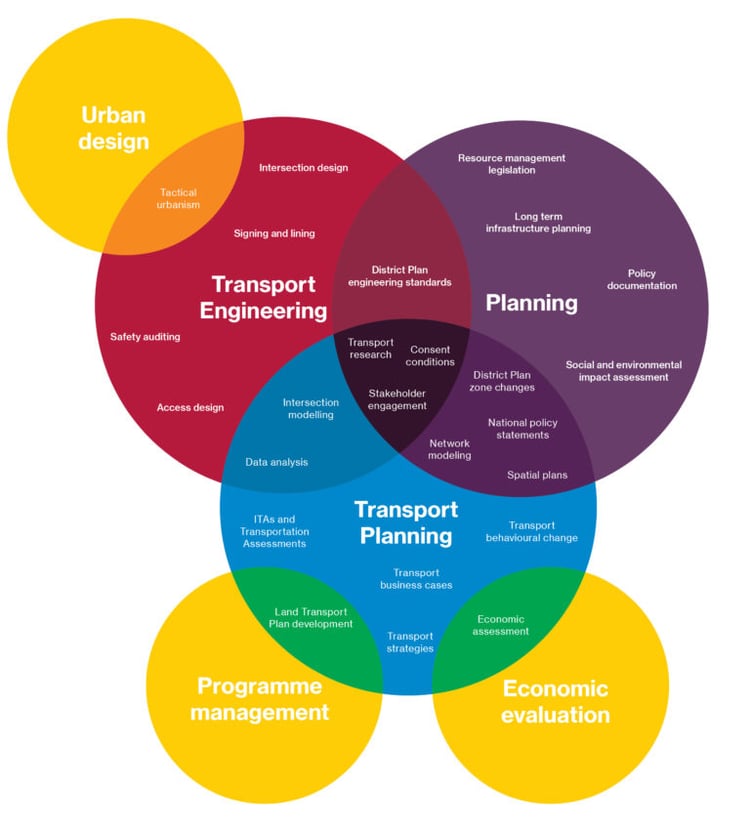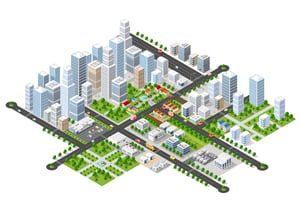Which profession’s role is it to provide advice on whether Auckland should have a new walking and cycling bridge? Whether a congestion charge is a good idea? Whether a supermarket will cause traffic congestion? Or how long you should be allowed to park on street? It’s not the job of a transport engineer, or a land use planner, or a project manager, or a politician. That’s the job of a transport planner. I’ve been a transport planner for my whole career. Every time I meet someone new, virtually without fail, I have to explain what I do:
It’s a bit like town planning. No, I’m not an engineer. Imagine you’re building a supermarket” are some of my go to phrases.
Even people who work in transport often struggle to understand that no, we’re not engineers, and no, we’re not planners either. As an aside, I’m often accused of being a traffic engineer, but in reality, there is no such profession any more, Transport Engineering is the correct term, since ‘traffic’ is not our only concern. The adjacent graphic shows how a lot of people envisage the industry.

Conventional view of Transport and Planning
Transport engineering or planning?
Confusion arises because often transport planners do transport engineering, and transport engineers also do transport planning. Both work alongside planners. Transport planning is a distinctly different profession. We generally have not done an engineering or planning degree, and often come from a geography, economics, science, logistics, or academic background.
Some of us even have transport planning specific degrees. Transport planning is not land use planning – even though transport planners often have knowledge of the Resource Management Act and consenting processes and provide advice to planners. Nor is it transport engineering, though often transport planners can, and do provide transport engineering advice, like how wide a cycle path might need to be, or whether a new access location can operate safely. In many countries transport planning precedes engineering inputs to ensure a holistic approach to design.

Broad Interrelationship between Transport Engineering, Planning and Transport Planning
The connection between land use and transport outcomes
I like to describe transport planning as the connection between land use and transport outcomes (see below). Transport planners are the people who do the thinking about what impact a change in land use will have on transport outcomes for people, and conversely, what a change in transport design will have on land use.
How Transport Planning links Transport Engineering and Land Use Planning
Here are some examples to help illustrate my point. Firstly, let’s look at how land use affects transport outcomes. In Auckland the Terrace Housing and Apartment Building (THAB) zone permits multi-storey apartments. Looking at Auckland’s Unitary Plan we see that these zones are clustered around transit nodes like railway stations. This illustration shows the THAB zone in orange clustered around Mount Albert Railway Station.

How Transport Planning links Transport Engineering and Land Use Planning
While a high-density development in another location might lead to significant vehicular travel demand, the theory is that those living within walking distance of a transit node have the opportunity to use public transport. These people are therefore less likely to own cars and more likely to walk and cycle or use public transport.
Some developers have proposed developments with no parking, in locations such as Mount Albert and Grey Lynn in Auckland. Long term, integrated land use planning can affect demand for public transport, on-street parking or pedestrian crossing facilities.

Land use zoning – Mount Albert Station and surrounds
Conversely, the construction of significant transport infrastructure shapes and connects the built environment. In Wellington a cable car (actually a funicular railway) was constructed in 1902, permitting the development of the suburb of Kelburn, until then a steep uphill walk from the city. In Auckland the construction of the Harbour Bridge in 1959 triggered the development of areas like Glenfield in the 1960s. Until this point the North Shore was mainly farmland. In both cases the significant reduction in travel time is the factor which led to the development of land, although one was a low carbon outcome and the other a high carbon outcome. Of course, the high carbon outcome could have been better if the bridge design had included active travel provision, but that’s another story.
Transport planners might prepare public transport strategies, parking management strategies, travel behaviour change strategies or walking and cycling strategies. This is to reinforce positive outcomes for equity, liveability, wellbeing, safety and inclusivity.
Key tasks of transport planners
Some key tasks of transport planners, land use planners and transport engineers can sit within one, two or all three disciplines. Some common tasks are identified below, noting that some aspects of work, like safe systems approaches, zero carbon approach, or inclusivity, apply holistically across our workload. The diagram includes a couple of other disciplines and activities as examples that also overlap with transport planning and engineering tasks.
Some tasks transport planners perform are actually land use planning or transport engineering tasks. For example, I believe that tactical urbanism lies within the remit of transport engineers and urban designers. That’s not to say that a transport planner can’t contribute to tactical urbanism or provide advice on the design of a pedestrian crossing, in the same way that a farmer can also be a skilled retailer and businessperson.
Transport planning is a separate, distinct profession with representation throughout many organisations. As we are not generally engineers or planners, we are not readily recognised by organisations such as Engineering NZ or the NZ Planning Institute. Future developments in the industry include consideration of professional recognition for transport planners, which we hope will raise our profile and may help encourage people into this profession.

What is a transport planning task?
.png?width=556&height=152&name=Abley_MasterLogo-Website%20(1).png)


